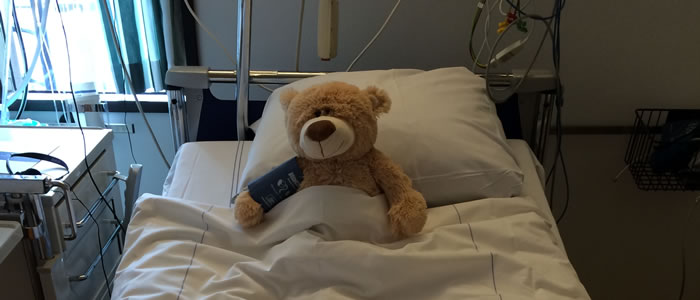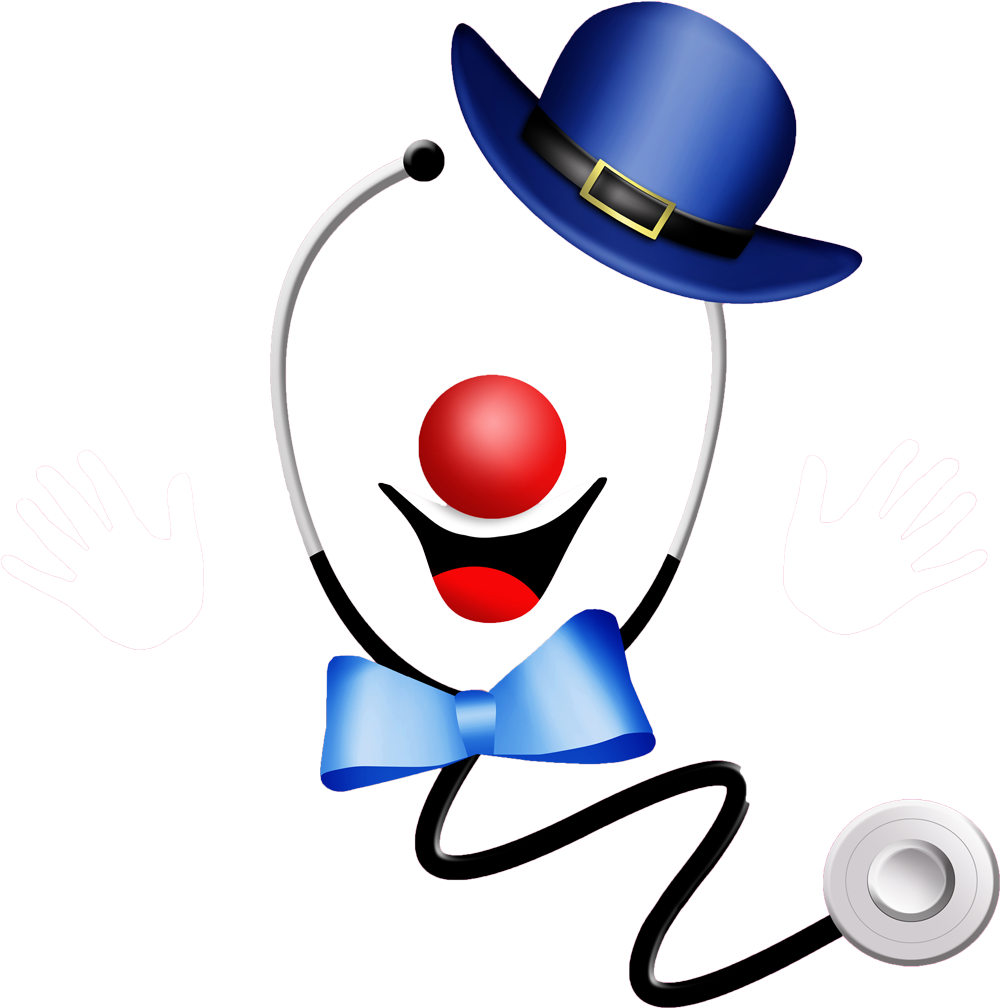When nurses are asked what job they do, the tone is often subdued and respectful. The other person will then say with some certainty: “I couldn’t do that, because there is so much suffering.” That is partly true. At the same time, however, there are endless funny situations and cheerfulness in everyday care. The author shows how to Use humour when dealing with patients.
Patients find humour helpful
A study of what patients want from caregivers found that they often find humour helpful. It creates distance to current fear and worry. Patients feel particularly accepted and valued as people when nurses meet them with humour or respond to their jokes. The following example, told by a health and nursing student in the second year of training:
 “During delusional thinking, a 40-year-old woman jumped out of a window and came to the hospital with multiple fractures. She was on strict bed rest. It was almost impossible to contact her. She answered questions briefly. Facial expressions and gestures were rigid and sad. Attempts to establish a trusting relationship with basal stimulation, among other things, failed. In order to build trust, I regularly carried out body care.
“During delusional thinking, a 40-year-old woman jumped out of a window and came to the hospital with multiple fractures. She was on strict bed rest. It was almost impossible to contact her. She answered questions briefly. Facial expressions and gestures were rigid and sad. Attempts to establish a trusting relationship with basal stimulation, among other things, failed. In order to build trust, I regularly carried out body care.
Once she burst into tears and confided in me her fears. She asked me when Sister X would be on duty again. At the prospect of seeing her again in the evening, she reacted with a deep sigh, made a face and said that she had problems with her. Maybe I would have an idea how best to deal with her. I told her I knew something. I suggested she ring the bell every five minutes and ask for the bedpan. Then she started laughing out loud. Of course, I made it clear through facial expressions and tone that this was a joke and not to be taken seriously. She also took the situation as a joke and responded at the same level. She also had an idea. For example, she could ring the bell at 10 p.m. and ask for breakfast.
Nobody in the room could stop laughing. This was the first situation in which the patient laughed. It was very impressive to see someone who is otherwise so introverted laughing from the bottom of their hearts. She kept infecting me. When the situation calmed down, I seriously answered her question. While distributing the evening medication, I jokingly said that this was the laxative for tonight. The patient agreed immediately. The comedy of the situation opened up access for the patient.”
This is situational humour that cannot be planned, but lives from the participants and their sense of humour and comedy as well as creativity, courage, respect and sensitivity to the situation.
What is humour?
 Humour is a human phenomenon that can be found in all cultures of the world and is associated with different terms. These can be: wit, comedy, satire, cheerfulness, hilarity, comedy, parody, irony, cheerfulness or laughter. History shows that there was laughter in all centuries – albeit on different occasions. Some things, like mockery of the lazy and stupid, were allowed. Others are banned, such as laughing at people with disabilities today. Humans have a sense of humour that is systematically developed during childhood through play and pleasurable experience. Psychology assigns the ability to have a sense of humour to the “cheerfulness” characteristic of a person. Cheerful composure is particularly helpful in coping with adverse living conditions. This can be developed and trained.
Humour is a human phenomenon that can be found in all cultures of the world and is associated with different terms. These can be: wit, comedy, satire, cheerfulness, hilarity, comedy, parody, irony, cheerfulness or laughter. History shows that there was laughter in all centuries – albeit on different occasions. Some things, like mockery of the lazy and stupid, were allowed. Others are banned, such as laughing at people with disabilities today. Humans have a sense of humour that is systematically developed during childhood through play and pleasurable experience. Psychology assigns the ability to have a sense of humour to the “cheerfulness” characteristic of a person. Cheerful composure is particularly helpful in coping with adverse living conditions. This can be developed and trained.
Humour techniques can be divided into: exaggeration, incongruence, understatement and reversal/parodoxes.
Dr Rolf Hirsch, gerontopsychiatrist, says: “A geriatric nurse speaks to a passing woman with dementia: “Please come with me. We’re going to the toilet now!” She replies: “You chose the wrong person, I didn’t find it either.”
Humour finds expression in laughter, smiles and smirks and is associated with the emotion of joy and amusement. The feeling is pleasurable and positive and unfolds physical, mental, social and spiritual effects.
Humour affects the body, soul and relationship
Gelotology, the science of laughter, examines how humour affects people. Nurses can use these insights to contribute to a better quality of life for their patients.
Laughter causes extensive bodily structures to be used and has amazing effects on the person: 17 facial muscles are tensed, tears are produced, the nose is wrinkled, nostrils and mouth are dilated. Breathing is intermittent, deepened and accelerated, the vocal cords vibrate and the typical staccato-like laughing sounds are produced. The chest also vibrates and can even be pulled painfully. The sides can hurt from laughing. The body moves back and forth, the diaphragm massages the intestines. Laughter is liberating and control of the body is lost in that moment.
As a result, more oxygen is absorbed, the metabolism is accelerated and the cardiovascular system is trained. It has been proven that stress hormones are reduced with an effect that corresponds to at least ten minutes of jogging or 25 minutes of relaxation exercises. At the same time, endorphins are produced and the immune system is strengthened.
Humour in nursing
 Vera Robinson, an American nurse, was the first to collect funny situations, healthcare jokes, and nursing and educational anecdotes in the mid-20th century. She wrote her doctoral thesis about it and showed that nursing is just as interested in humour as in phenomena such as fear, frustration or conflict behavior. Her example caught on.
Vera Robinson, an American nurse, was the first to collect funny situations, healthcare jokes, and nursing and educational anecdotes in the mid-20th century. She wrote her doctoral thesis about it and showed that nursing is just as interested in humour as in phenomena such as fear, frustration or conflict behavior. Her example caught on.
Clinic clowns are now part of everyday life in children’s hospitals. But you can bring humour everywhere with simple means:
- The library can be filled with humourous audio books and videos
- Stock humour boxes with films, paraphernalia and books
- Watch cartoons with patients and family members
- Wearing funny clothes, clown noses or hats
- Telling funny stories and jokes
- Invitation of clowns or storytellers.
Tips for caregivers to better cope with their everyday life:
- Shaping the work and life rhythm with games and humourous breaks to prevent burn-out
- Expansion of one’s own skills in training and work through humourous exercises
- Design of the workplace with humour-promoting elements such as humourous pictures.
Humour in the outpatient area
Humour is cited as a valuable tool for reaching out to older people in the home during health care visits. It serves to develop the motivation and ability to cooperate of older people. In this way, ambulatory care workers, patients themselves or family/friends can collect and tell jokes and funny stories.
Incidentally, it is remarkable that humour is prescribed on prescription in some countries. Humour is used therapeutically in laughter courses run by professionals or in laughter yoga.
Humour in elderly care
A trusting atmosphere in which a so-called humour milieu can be created is beneficial. To serve:
- Funny pictures, caricatures, joke calendars, figures in corridors and rooms or in toilets and washrooms
- Humour boxes as libraries with films, books, CDs, laughter
- Events with clowns, film screenings, skits, reading and telling jokes, laughter, games, dance and music events, casual competitions, etc.
Please let me know what you do for spreading humour !!





 Humour is a human phenomenon that can be found in all cultures of the world and is associated with different terms. These can be: wit, comedy, satire, cheerfulness, hilarity, comedy, parody, irony, cheerfulness or laughter. History shows that there was laughter in all centuries – albeit on different occasions. Some things, like mockery of the lazy and stupid, were allowed. Others are banned, such as laughing at people with disabilities today. Humans have a sense of humour that is systematically developed during childhood through play and pleasurable experience. Psychology assigns the ability to have a sense of humour to the “cheerfulness” characteristic of a person. Cheerful composure is particularly helpful in coping with adverse living conditions. This can be developed and trained.
Humour is a human phenomenon that can be found in all cultures of the world and is associated with different terms. These can be: wit, comedy, satire, cheerfulness, hilarity, comedy, parody, irony, cheerfulness or laughter. History shows that there was laughter in all centuries – albeit on different occasions. Some things, like mockery of the lazy and stupid, were allowed. Others are banned, such as laughing at people with disabilities today. Humans have a sense of humour that is systematically developed during childhood through play and pleasurable experience. Psychology assigns the ability to have a sense of humour to the “cheerfulness” characteristic of a person. Cheerful composure is particularly helpful in coping with adverse living conditions. This can be developed and trained. Vera Robinson, an American nurse, was the first to collect funny situations, healthcare jokes, and nursing and educational anecdotes in the mid-20th century. She wrote her doctoral thesis about it and showed that nursing is just as interested in humour as in phenomena such as fear, frustration or conflict behavior. Her example caught on.
Vera Robinson, an American nurse, was the first to collect funny situations, healthcare jokes, and nursing and educational anecdotes in the mid-20th century. She wrote her doctoral thesis about it and showed that nursing is just as interested in humour as in phenomena such as fear, frustration or conflict behavior. Her example caught on.
